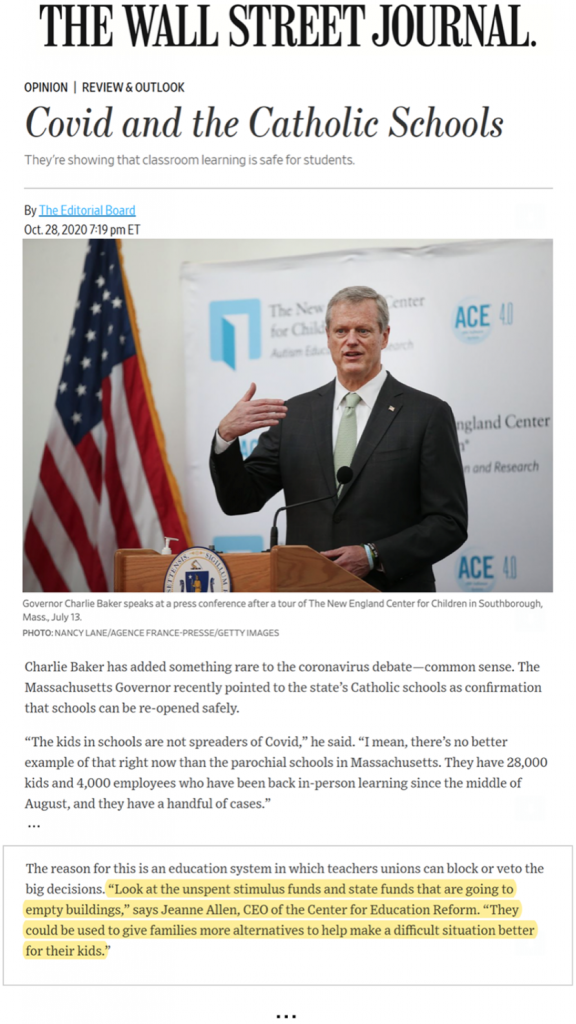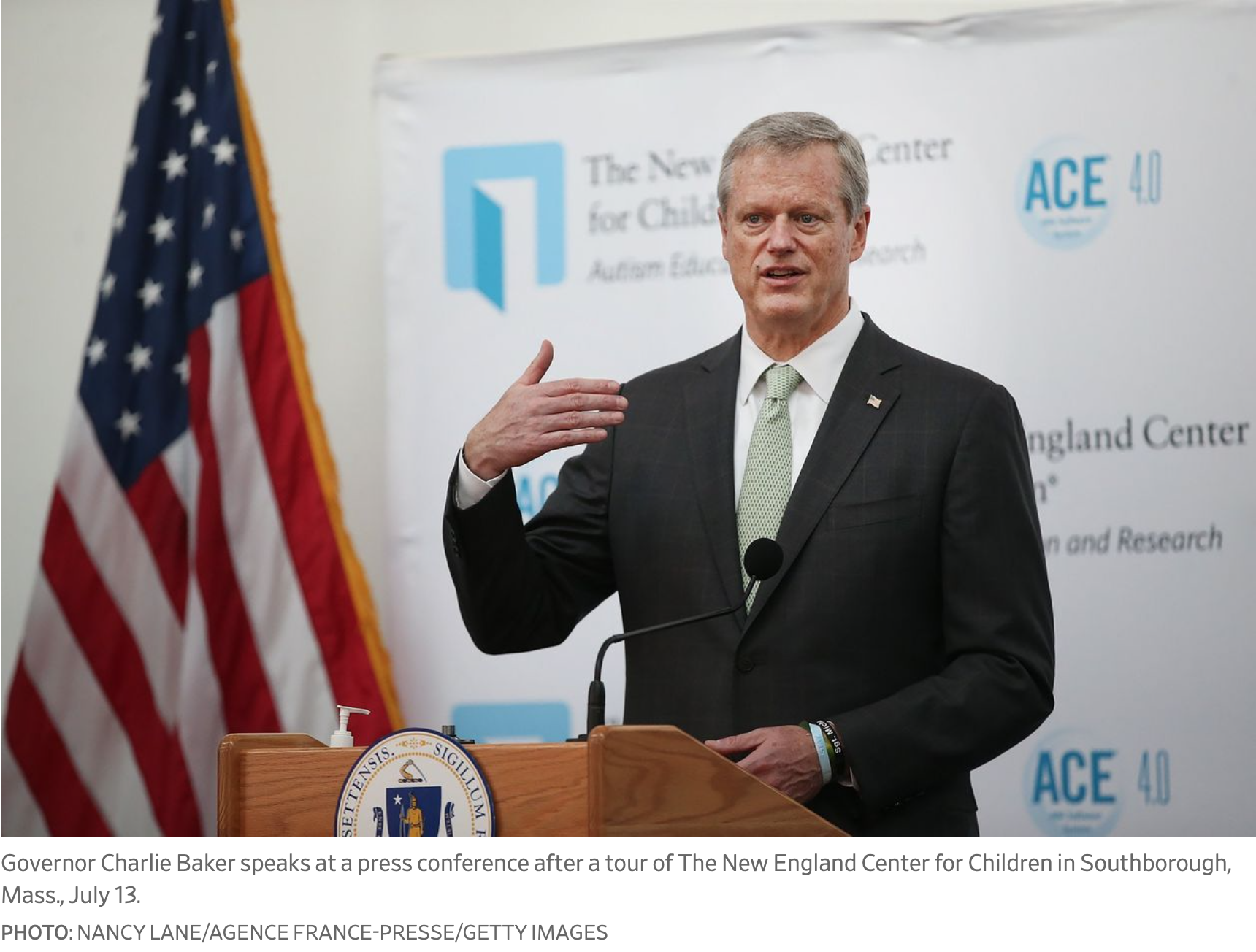Covid and the Catholic Schools


Covid and the Catholic Schools
They’re showing that classroom learning is safe for students.
The Wall Street Journal | October 28, 2020
By The Editorial Board

Charlie Baker has added something rare to the coronavirus debate—common sense. The Massachusetts Governor recently pointed to the state’s Catholic schools as confirmation that schools can be re-opened safely.
“The kids in schools are not spreaders of Covid,” he said. “I mean, there’s no better example of that right now than the parochial schools in Massachusetts. They have 28,000 kids and 4,000 employees who have been back in-person learning since the middle of August, and they have a handful of cases.”
Mr. Baker added that hundreds of thousands of public school students have also returned to the classroom under the hybrid model—and there have been only 150 to 160 Covid cases. In short, “real life experience and the research” shows that classrooms “are not a major source of transmission,” he said.
The Governor’s remarks arrived just before the latest National Assessment of Educational Progress test scores came on Wednesday. They aren’t good news. Only 37% of high school seniors are proficient or above in reading and only 24% in math, virtually unchanged from 2015. These are disgraceful enough. But for the lowest performers, there was a decline in both subjects.
These scores are based on pre-Covid testing. The Centers for Disease Control and Prevention has warned that keeping kids out of the classroom “disproportionately harms low-income and minority children and those living with disabilities. These students are far less likely to have access to private
instruction and care and far more likely to rely on key school-supported resources like food programs, special education services, counseling, and after-school programs to meet basic developmental needs.”
So imagine what these scores will be like a year from now—especially for low-income and minority children already struggling. The NAEP scores should be taken as a warning cry about the long-term human costs that will be inflicted if these children are forced to spend a whole year outside classrooms.
The reason for this is an education system in which teachers unions can block or veto the big decisions. “Look at the unspent stimulus funds and state funds that are going to empty buildings,” says Jeanne Allen, CEO of the Center for Education Reform. “They could be used to give families more alternatives to help make a difficult situation better for their kids.”
As Gov. Baker suggests, the positive experience of the parochial schools in handling Covid-19 while reopening their classrooms clearly shows the unions have been wrong to fight school re-openings. But they get away with it because the public schools answer mostly to them and not to the families they are supposed to serve. More school choice is as much a public-health fix as it is an education reform.
Follow Jeanne on Twitter or LinkedIn or some of her other work here.
By The Editorial Board

Charlie Baker has added something rare to the coronavirus debate—common sense. The Massachusetts Governor recently pointed to the state’s Catholic schools as confirmation that schools can be re-opened safely.
“The kids in schools are not spreaders of Covid,” he said. “I mean, there’s no better example of that right now than the parochial schools in Massachusetts. They have 28,000 kids and 4,000 employees who have been back in-person learning since the middle of August, and they have a handful of cases.”
Mr. Baker added that hundreds of thousands of public school students have also returned to the classroom under the hybrid model—and there have been only 150 to 160 Covid cases. In short, “real life experience and the research” shows that classrooms “are not a major source of transmission,” he said.
The Governor’s remarks arrived just before the latest National Assessment of Educational Progress test scores came on Wednesday. They aren’t good news. Only 37% of high school seniors are proficient or above in reading and only 24% in math, virtually unchanged from 2015. These are disgraceful enough. But for the lowest performers, there was a decline in both subjects.
These scores are based on pre-Covid testing. The Centers for Disease Control and Prevention has warned that keeping kids out of the classroom “disproportionately harms low-income and minority children and those living with disabilities. These students are far less likely to have access to private
instruction and care and far more likely to rely on key school-supported resources like food programs, special education services, counseling, and after-school programs to meet basic developmental needs.”
So imagine what these scores will be like a year from now—especially for low-income and minority children already struggling. The NAEP scores should be taken as a warning cry about the long-term human costs that will be inflicted if these children are forced to spend a whole year outside classrooms.
The reason for this is an education system in which teachers unions can block or veto the big decisions. “Look at the unspent stimulus funds and state funds that are going to empty buildings,” says Jeanne Allen, CEO of the Center for Education Reform. “They could be used to give families more alternatives to help make a difficult situation better for their kids.”
As Gov. Baker suggests, the positive experience of the parochial schools in handling Covid-19 while reopening their classrooms clearly shows the unions have been wrong to fight school re-openings. But they get away with it because the public schools answer mostly to them and not to the families they are supposed to serve. More school choice is as much a public-health fix as it is an education reform.
Follow Jeanne on Twitter or LinkedIn or some of her other work here.
Founded in 1993, the Center for Education Reform aims to expand educational opportunities that lead to improved economic outcomes for all Americans — particularly our youth — ensuring that conditions are ripe for innovation, freedom and flexibility throughout U.S. education.














